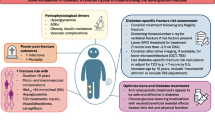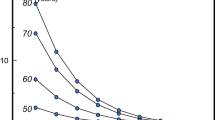Abstract
Background
Sclerostin has been directly related to bone turnover increase in dietary-induced weight loss in non-diabetics. This has not been studied in type 2 diabetes, a condition characterized by increased circulating sclerostin and impaired bone turnover.
Purpose
To study the effect of dietary weight loss and quality of the dietary intervention on changes of sclerostin and bone turnover markers in type 2 diabetes.
Methods
This was a post-hoc analysis of the MADIAB trial, a 21-day randomized controlled trial on overweight/obese type 2 diabetes patients. Patients were randomly assigned 1:1 to the Ma-Pi2 macrobiotic diet or a control diet based on dietary guidelines for type 2 diabetes. Serum sclerostin and circulating markers of bone resorption and formation (P1NP) were measured by enzyme linked immunosorbent assay in 40 subjects (1:1) at baseline and after 21 days treatment.
Results
Both Ma-Pi2 and the control diet groups had significant decreases in body weight (6.0 ± 0.2 vs. 3.2 ± 0.1 %, p < 0.001). Sclerostin increased significantly in the two groups (all p < 0.001) but Ma-Pi2 diet group experienced a greater increase in sclerostin (34.5 vs. 15 %; p = 0.024). Serum circulating markers of bone resorption increased in the two groups (all p < 0.001); circulating markers of bone resorption at the end of the treatment tended to be higher in Ma-Pi2 diet than the control diet group (p = 0.06). P1NP did not change significantly in the two group compared to baseline. Sclerostin changes were related to body mass index reduction (r = −0.37; p = 0.02).
Conclusions
Diet-induced weight loss may induce significant and rapid changes in bone turnover and sclerostin levels. These changes may further impair bone health in subjects with type 2 diabetes.

Similar content being viewed by others
References
International Diabetes Federation, IDF Atlas, 7th ed. Brussels, Belgium: International Diabetes Federation (2015)
A.H. Mokdad, E.S. Ford, B.A. Bowman, W.H. Dietz, F. Vinicor, V.S. Bales, J.S. Marks, Prevalence of obesity, diabetes, and obesity-related health risk factors, 2001. JAMA 289, 76–79 (2003)
Obesity management for the treatment of type 2 diabetes. American Diabetes Association. Diabetes Care 39, Suppl 1, S47–S51 (2016)
E.W. Lipkin, A.V. Schwartz, A.M. Anderson, C. Davis, K.C. Johnson, E.W. Gregg, G.A. Bray, R. Berkowitz, A.L. Peters, A. Hodges, C. Lewis, S.E. Kahn, The Look AHEAD Trial: bone loss at 4-year follow-up in type 2 diabetes. Diabetes Care 37, 2822–2829 (2014)
R. Armamento-Villareal, C. Sadler, N. Napoli, K. Shah, S. Chode, D.R. Sinacore, C. Qualls, D.T. Villareal, Weight loss in obese older adults increases serum sclerostin and impairs hip geometry but both are prevented by exercise training. J. Bone Miner. Res. 27, 1215–1221 (2012)
D.T. Villareal, S. Chode, N. Parimi, D.R. Sinacore, T. Hilton, R. Armamento-Villareal, N. Napoli, C. Qualls, K. Shah, Weight loss, exercise, or both and physical function in obese older adults. N. Engl. J. Med. 364, 1218–1229 (2011)
K. Shah, R. Armamento-Villareal, N. Parimi, S. Chode, D.R. Sinacore, T.N. Hilton, N. Napoli, C. Qualls, D.T. Villareal, Exercise training in obese older adults prevents increase in bone turnover and attenuates decrease in hip bone mineral density induced by weight loss despite decline in bone-active hormones. J. Bone Miner. Res. 26, 2851–2859 (2011)
N. Napoli, Questions on therapy with DPP-4 inhibitors and bone homeostasis. Diabetes Metab. Res. Rev. 30, 201–203 (2014)
A.V. Schwartz, K.C. Johnson, S.E. Kahn, J.A. Shepherd, M.C. Nevitt, A.L. Peters, M.P. Walkup, A. Hodges, C.C. Williams, G.A. Bray, Effect of 1 year of an intentional weight loss intervention on bone mineral density in type 2 diabetes: results from the Look AHEAD randomized trial. J. Bone Miner. Res. 27, 619–627 (2012)
M. Semenov, K. Tamai, X. He, SOST is a ligand for LRP5/LRP6 and a Wnt signaling inhibitor. J. Biol. Chem. 280, 26770–26775 (2005)
M.K. Sutherland, J.C. Geoghegan, C. Yu, E. Turcott, J.E. Skonier, D.G. Winkler, J.A. Latham, Sclerostin promotes the apoptosis of human osteoblastic cells: a novel regulation of bone formation. BONE 35, 828–835 (2004)
A.G. Robling, P.J. Niziolek, L.A. Baldridge, K.W. Condon, M.R. Allen, I. Alam, S.M. Mantila, J. Gluhak-Heinrich, T.M. Bellido, S.E. Harris, C.H. Turner, Mechanical stimulation of bone in vivo reduces osteocyte expression of Sost/sclerostin. J. Biol. Chem. 283, 5866–5875 (2008)
M. Yamamoto, M. Yamauchi, T. Sugimoto, Elevated sclerostin levels are associated with vertebral fractures in patients with type 2 diabetes mellitus. J. Clin. Endocrinol. Metab. 98, 4030–4037 (2013)
L. Gennari, D. Merlotti, R. Valenti, E. Ceccarelli, M. Ruvio, M.G. Pietrini, C. Capodarca, M.B. Franci, M.S. Campagna, A. Calabro, D. Cataldo, K. Stolakis, F. Dotta, R. Nuti, Circulating sclerostin levels and bone turnover in type 1 and type 2 diabetes. J. Clin. Endocrinol. Metab. 97, 1737–1744 (2012)
A. Gaudio, F. Privitera, K. Battaglia, V. Torrisi, M.H. Sidoti, I. Pulvirenti, E. Canzonieri, G. Tringali, C.E. Fiore, Sclerostin levels associated with inhibition of the Wnt/beta-catenin signaling and reduced bone turnover in type 2 diabetes mellitus. J. Clin. Endocrinol. Metab. 97, 3744–3750 (2012)
A. Garcia-Martin, P. Rozas-Moreno, R. Reyes-Garcia, S. Morales-Santana, B. Garcia-Fontana, J.A. Garcia-Salcedo, M. Munoz-Torres, Circulating levels of sclerostin are increased in patients with type 2 diabetes mellitus. J. Clin. Endocrinol. Metab. 97, 234–241 (2012)
N. Napoli, R. Strollo, A. Paladini, S.I. Briganti, P. Pozzilli, S. Epstein, The alliance of mesenchymal stem cells, bone, and diabetes. Int. J. Endocrinol. 2014, 690783 (2014)
A. Soare, Y.M. Khazrai, R. Del Toro, E. Roncella, L. Fontana, S. Fallucca, S. Angeletti, V. Formisano, F. Capata, V. Ruiz, C. Porrata, E. Skrami, R. Gesuita, S. Manfrini, F. Fallucca, M. Pianesi, P. Pozzilli, The effect of the macrobiotic Ma-Pi 2 diet vs. the recommended diet in the management of type 2 diabetes: the randomized controlled MADIAB trial. Nutr. Metab. (Lond). 11, 39 (2014)
A. Soare, R. Del Toro, E. Roncella, Y.M. Khazrai, S. Angeletti, L. Dugo, S. Fallucca, L. Fontana, M. Altomare, V. Formisano, F. Capata, R. Gesuita, S. Manfrini, F. Fallucca, M. Pianesi, P. Pozzilli, The effect of macrobiotic Ma-Pi 2 diet on systemic inflammation in patients with type 2 diabetes: a post hoc analysis of the MADIAB trial. BMJ Open Diabetes Res Care 3, e000079 (2015)
N. Napoli, J. Thompson, R. Civitelli, R.C. Armamento-Villareal, Effects of dietary calcium compared with calcium supplements on estrogen metabolism and bone mineral density. Am. J. Clin. Nutr. 85, 1428–1433 (2007)
C. Tudor-Locke, C.L. Craig, W.J. Brown, S.A. Clemes, K. De Cocker, B. Giles-Corti, Y. Hatano, S. Inoue, S.M. Matsudo, N. Mutrie, J.M. Oppert, D.A. Rowe, M.D. Schmidt, G.M. Schofield, J.C. Spence, P.J. Teixeira, M.A. Tully, S.N. Blair, How many steps/day are enough? For adults. Int. J. Behav. Nutr. Phys. Act. 8, 79 (2011)
M. Kosacka, A. Korzeniewska, R. Jankowska, The evaluation of body composition, adiponectin, C-reactive protein and cholesterol levels in patients with obstructive sleep apnea syndrome. Adv. Clin. Exp. Med. 22, 817–824 (2013)
X. Lai, C. Price, S. Modla, W.R. Thompson, J. Caplan, C.B. Kirn-Safran, L. Wang, The dependences of osteocyte network on bone compartment, age, and disease. Bone Res. 3, 15009 (2015)
A.R. Wijenayaka, M. Kogawa, H.P. Lim, L.F. Bonewald, D.M. Findlay, G.J. Atkins, Sclerostin stimulates osteocyte support of osteoclast activity by a RANKL-dependent pathway. PLoS ONE 6, e25900 (2011)
G.J. Atkins, P.S. Rowe, H.P. Lim, K.J. Welldon, R. Ormsby, A.R. Wijenayaka, L. Zelenchuk, A. Evdokiou, D.M. Findlay, Sclerostin is a locally acting regulator of late-osteoblast/preosteocyte differentiation and regulates mineralization through a MEPE-ASARM-dependent mechanism. J. Bone. Miner. Res. 26, 1425–1436 (2011)
C. Muschitz, R. Kocijan, C. Marterer, A.R. Nia, G.K. Muschitz, H. Resch, P. Pietschmann, Sclerostin levels and changes in bone metabolism after bariatric surgery. J. Clin. Endocrinol. Metab. 100, 891–901 (2015)
J. Zibellini, R.V. Seimon, C.M. Lee, A.A. Gibson, M. Hsu, S.A. Shapses, T.V. Nguyen, A. Sainsbury, does diet-induced weight loss lead to bone loss in overweight or obese adults? A systematic review and meta-analysis of clinical trials. J. Bone. Miner. Res. 30, 2168–2178 (2015)
R. Civitelli, R. Armamento-Villareal, N. Napoli, Bone turnover markers: understanding their value in clinical trials and clinical practice. Osteoporos. Int. 20, 843–851 (2009)
K. Amrein, S. Amrein, C. Drexler, H.P. Dimai, H. Dobnig, K. Pfeifer, A. Tomaschitz, T.R. Pieber, A. Fahrleitner-Pammer, Sclerostin and its association with physical activity, age, gender, body composition, and bone mineral content in healthy adults. J. Clin. Endocrinol. Metab. 97, 148–154 (2012)
T. Urano, M. Shiraki, Y. Ouchi, S. Inoue, Association of circulating sclerostin levels with fat mass and metabolic disease–related markers in Japanese postmenopausal women. J. Clin. Endocrinol. Metab. 97, E1473–1477 (2012)
R. Thibault, C. Pichard, The evaluation of body composition: a useful tool for clinical practice. Ann. Nutr. Metab. 60, 6–16 (2012)
E. Ishimura, S. Okuno, M. Ichii, K. Norimine, T. Yamakawa, S. Shoji, Y. Nishizawa, M. Inaba, Relationship between serum sclerostin, bone metabolism markers, and bone mineral density in maintenance hemodialysis patients. J. Clin. Endocrinol. Metab. 99, 4315–4320 (2014)
A. Tirosh, R.J. de Souza, F. Sacks, G.A. Bray, S.R. Smith, M.S. LeBoff, Sex differences in the effects of weight loss diets on bone mineral density and body composition: pounds lost trial. J. Clin. Endocrinol. Metab. 100, 2463–2471 (2015)
C. Pedone, N. Napoli, P. Pozzilli, F.F. Rossi, F. Lauretani, S. Bandinelli, L. Ferrucci, R. Antonelli-Incalzi, Dietary pattern and bone density changes in elderly women: a longitudinal study. J. Am. Coll. Nutr. 30, 149–154 (2011)
S.A. Polyzos, A.D. Anastasilakis, C. Bratengeier, et al., Serum sclerostin levels positively correlate with lumbar spinal bone mineral density in postmenopausal women–the six-month effect of risedronate and teriparatide. Osteoporos. Int. 23, 1171–1176 (2012) doi:10.1007/s00198-010-1525-6
Z. Feldbrin, M. Shargorodsky, Bone remodelling markers in hypertensive patients with and without diabetes mellitus: link between bone and glucose metabolism. Diabetes. Metab. Res. Rev. 31, 752–757 (2015)
F.S. Mirza, I.D. Padhi, L.G. Raisz, J.A. Lorenzo, Serum sclerostin levels negatively correlate with parathyroid hormone levels and free estrogen index in postmenopausal women. J. Clin. Endocrinol Metab. 95, 1991–1997 (2010). doi:10.1210/jc.2009-2283
M.-S.M. Ardawi, H.A. Al-Kadi, A.A. Rouzi, M.H. Qari, Determinants of serum sclerostin in healthy pre- and postmenopausal women. J. Bone Miner. Res. 26, 2812–2822 (2011). doi:10.1002/jbmr.479
U.I. Mödder, K.A. Hoey, S. Amin, et al., Relation of age, gender, and bone mass to circulating sclerostin levels in women and men. J. Bone Miner. Res. 26, 373–379 (2011). doi:10.1002/jbmr.217
Acknowledgment
The research was sponsored by Un Punto Macrobiotico Association
Authors’ contributions
RS was responsible for the analysis and interpretation of data, writing the manuscript and revising it critically for important intellectual content. AS collected data and contributed to write the manuscript. YMK revised the manuscript critically for important intellectual content. ADM contributed to the writing of the manuscript and revised it critically for important intellectual content. RDT and SF collected data. MGB and LD contributed to the acquisition of data and analysis. MP made substantial contribution to interpretation of data and revising the manuscript critically for important intellectual content. PP collected data, made substantial contribution to interpretation of data and revising the manuscript critically for important intellectual content and, being the guarantor of this work, had full access to all the data in the study and takes responsibility for the integrity of the data and the accuracy of the data analysis. NN designed this post-hoc analysis, made substantial contribution to interpretation of data, contributed to the writing of the manuscript and revised it critically for important intellectual content. All authors read and approved the final manuscript.
Funding
This study was supported by Un Punto Macrobiotico Association, a charity/not-for-profit organization that provided the food required for the trial and supported the cost of CGM analyses. The research sponsors played no role in the design or conduct of the study, collection, management, analysis or interpretation of the data.
Author information
Authors and Affiliations
Corresponding author
Ethics declarations
Conflict of interest
The authors declare that they have no competing interests.
Electronic supplementary material
Rights and permissions
About this article
Cite this article
Strollo, R., Soare, A., Manon Khazrai, Y. et al. Increased sclerostin and bone turnover after diet-induced weight loss in type 2 diabetes: a post hoc analysis of the MADIAB trial. Endocrine 56, 667–674 (2017). https://doi.org/10.1007/s12020-016-1171-7
Received:
Accepted:
Published:
Issue Date:
DOI: https://doi.org/10.1007/s12020-016-1171-7




